When you get a brand new griddle, the first thing you need to do is season it. And one of the most popular questions that I get is “What is the best oil for seasoning a griddle?”.
If you invest a few hundred dollars to buy a new flat top grill, the last thing you want to do is mess up on the seasoning and have to redo it, all because you chose the wrong griddle seasoning oil.
So in this post, I’ll go through the features that you should look for in a seasoning oil, as well as my three favorite oils for seasoning my griddles and flat top grills.
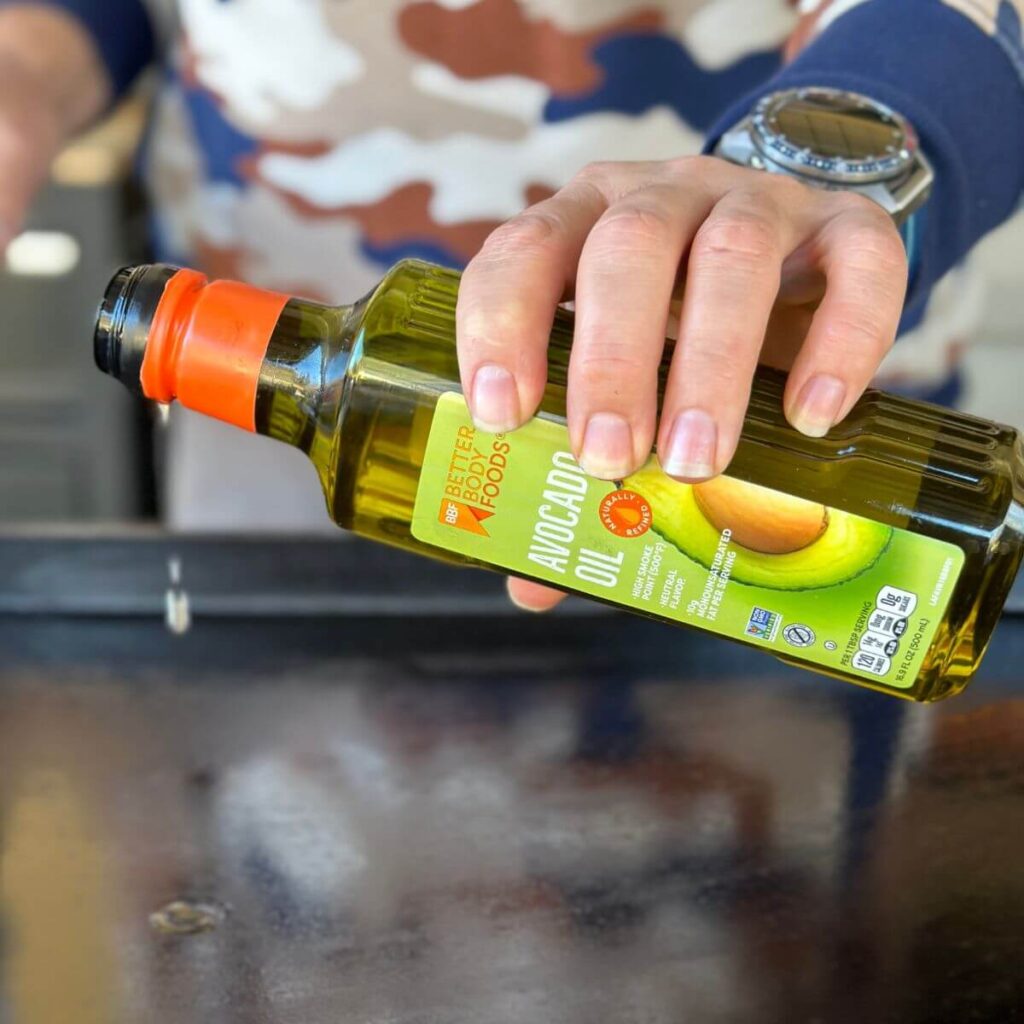
*This post contains affiliate links, which means if you click a link and make a purchase, I earn a commission at no additional cost to you. Read my full terms of use for more info.
What to Look for in a Griddle Seasoning Oil
Standing in the oil aisle of the grocery store with hundreds (literally) of oil types and brands is incredibly overwhelming. Especially if you’re not familiar with cooking on a griddle, or if you’ve never owned a piece of cast iron cookware.
Sunflower oil, flaxseed oil, avocado oil, grapeseed oil, vegetable oil… you can even buy oils that you’ve probably never heard of, like hemp oil or rice bran oil. But which oils are right for the high heat cooking capabilities of an outdoor griddle?
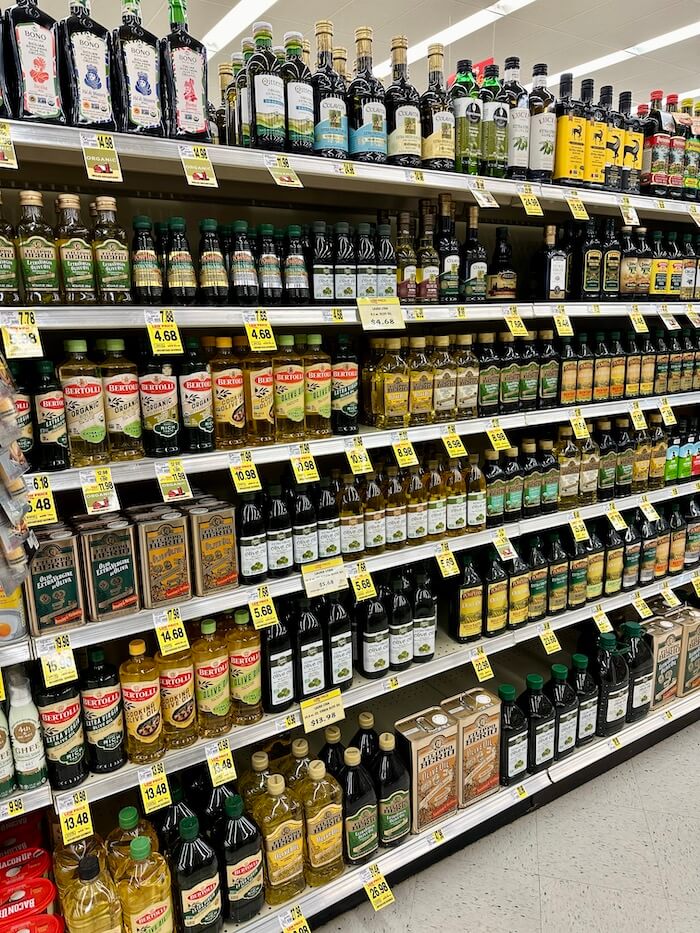
If you’re trying to decide which oil to buy for seasoning your griddle, then here are the most important things to look for:
High Smoke Point
If you’re new to griddle cooking, then get ready to hear this phrase often – “smoke point”.
Many griddle users reference an oil’s smoke point when talking about which oils are best, but what exactly is the smoke point of an oil, and why does it matter when you’re standing in the grocery store perusing your options?

The smoke point of an oil is the temperature at which it starts to smoke and burn. But when an oil gets heated too far past its smoke point, then the “fat starts to break down, releasing free radicals and a substance called acrolein, the chemical that gives burnt foods their acrid flavor and aroma.” In addition, exceeding the smoke point of an oil gets you closer to its flash point, which could result in actual flames on your griddle (not what you want with griddle cooking!).
So the smoke point of an oil is arguably the most important factor when selecting what oil to use to season your griddle. Because griddle temperatures can easily climb into the 450-500°F range, depending on what griddle you own and the volume of food that you’re cooking, you’ll want to look for an oil with a higher smoke point, preferably above 450°F.
Neutral Flavor
You don’t want your favorite griddle pancakes (or anything else that you’re cooking) to take on the flavor of the oil that you used to season your griddle, so look for an oil that is neutral in flavor.
Also, a neutral-flavored oil is going to be more versatile, so instead of buying a large bottle of oil that you only use for seasoning your griddle or cast iron, you can buy a good neutral oil that can be used for sautéing vegetables, crisping up hash browns, and seasoning your flat top grill.
Some of the most popular neutrally-flavored oils include:
- vegetable oil
- avocado oil
- grapeseed oil
- corn oil
- canola oil
- peanut oil
- sunflower oil
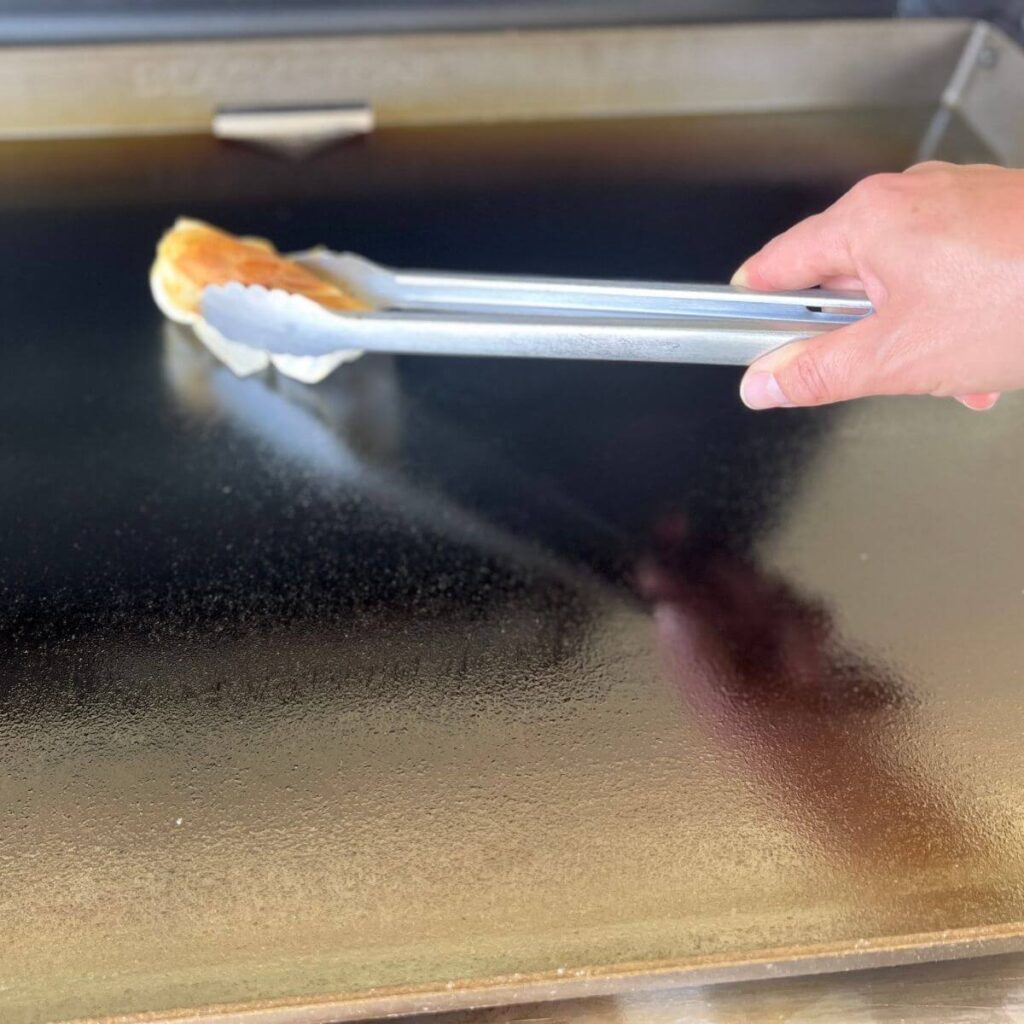
Affordable Price Point
Because griddle seasoning involves applying multiple thin coats of oil to the surface, you may want to look for a less expensive seasoning oil. When seasoning a brand new Blackstone or other flat top grill, I typically use about 5-6 layers of oil.
But it’s important to remember that griddle seasoning is an ongoing task, and even after you’ve applied your first few layers of seasoning, you’ll need to add more seasoning periodically to maintain the quality of your griddle surface. Lower-priced oils allow you to apply multiple coats without breaking the bank, making it easier for griddle enthusiasts to prioritize the regular maintenance of their griddle without cringing when they get up to the grocery store checkout.
The Best Oils to Season a Griddle
Choosing the best oil to season a griddle is crucial in the seasoning process. If you use the wrong oil, your griddle surface will be sticky or the seasoning layer may flake off easily. Here are my three favorite oils for seasoning a griddle:
1. Avocado Oil
Avocado oil has gained popularity in the culinary world for its numerous health benefits and versatility. When it comes to seasoning your griddle, here’s why avocado oil is one of my favorite options:
- High Smoke Point – The smoke point of refined avocado oil is around 520°F, one of the highest that you can find.
- Neutral Flavor – Unlike some oils that might impart a distinct flavor to your dishes, avocado oil has a mild and neutral taste. This ensures that your griddle-cooked masterpieces retain their authentic flavors without interference from the seasoning oil.
- Versatility – Because of its high heat cooking capabilities, neutral flavor, and concentration of healthy fats, I use avocado oil for both cooking and griddle seasoning. The versatility of avocado oil makes it a pantry staple in my kitchen.
- Nutrient-rich and Healthier than Other Oil Options – Avocado oil is higher in monounsaturated fats, which are considered to be heart-healthy, and it’s lower in saturated fats than some other oil options.
The two brands of avocado oil that I mainly use are:
- Better Body Foods Avocado Oil – Available here
- Chosen Foods 100% Pure Avocado Oil – Available here, or you can buy it at Costco for a great price!
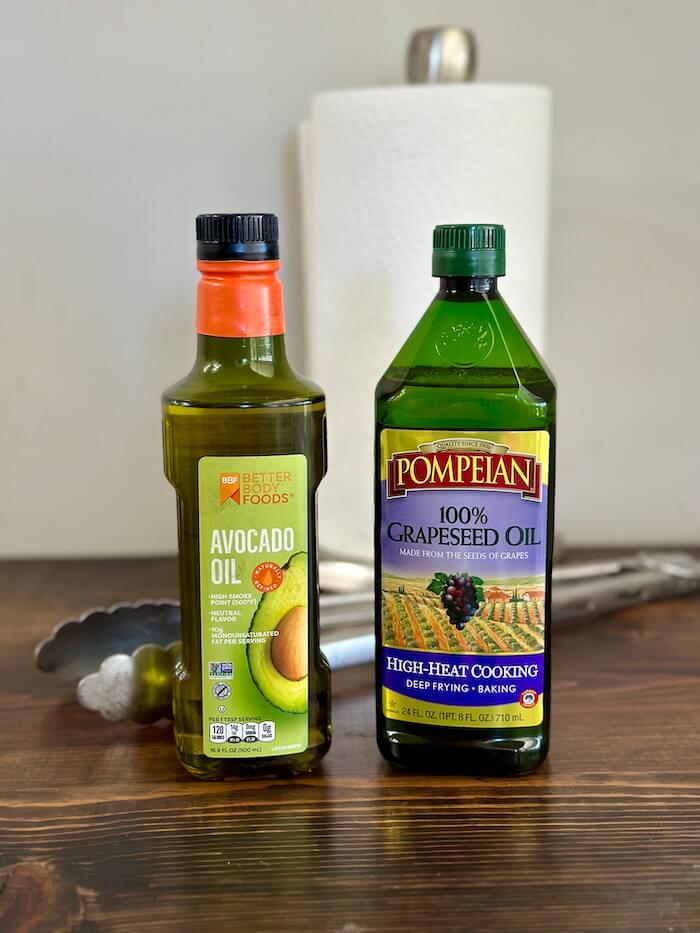
2. Grapeseed Oil
I’m listing grapeseed oil second as the best oil for seasoning a griddle, but it’s really neck-and-neck with avocado oil, since grapeseed oil has many of the same properties.
Here are some of the benefits of using grapeseed oil to season your griddle or flat top grill:
- High Smoke Point – The grape seed oil that I use has a smoke point of 470-510°F, making it one of the best oils for seasoning a griddle.
- Light and Neutral Flavor – Grapeseed oil has a light and neutral flavor profile so it doesn’t interfere with the flavors of your flat top grill recipes, making it an ideal choice for griddle seasoning oil.
- Quick Drying and Absorption – Grapeseed oil is known for its quick drying and absorption properties. This means that the oil efficiently penetrates the griddle surface, forming a smooth and protective layer that enhances the non-stick capabilities of your cooking surface.
3. Crisco (or Vegetable Shortening)
Before I made the switch to avocado oil and grapeseed oil, I used Crisco vegetable shortening for years to season my griddles and cast iron cookware, based largely on the recommendations of Lodge, my favorite cast iron manufacturer.
Though Crisco does have a lower smoke point than the other two griddle seasoning oil options that I’ve listed, it does have some qualities that make it great for seasoning your flat top grill including:
- Neutral Flavor Profile – Vegetable shortening boasts a neutral flavor, ensuring that it won’t impart any unwanted tastes to your dishes.
- Easy Application – Vegetable shortening’s solid state at room temperature makes it easy to apply and distribute on the griddle surface. Simply scoop out a small amount, add it to the griddle surface, and it will immediately start melting, making it easy to spread evenly across the cooking area.
*If you choose to use Crisco, stick with the non-flavored variety NOT the butter flavored Crisco.
Oils to Avoid When Seasoning Your Griddle
There are a few popular oils that people commonly have in their pantries that are definitely NOT suited for griddle seasoning or high-heat cooking. You should avoid these oils and fats when choosing what oil to use to season your griddle:
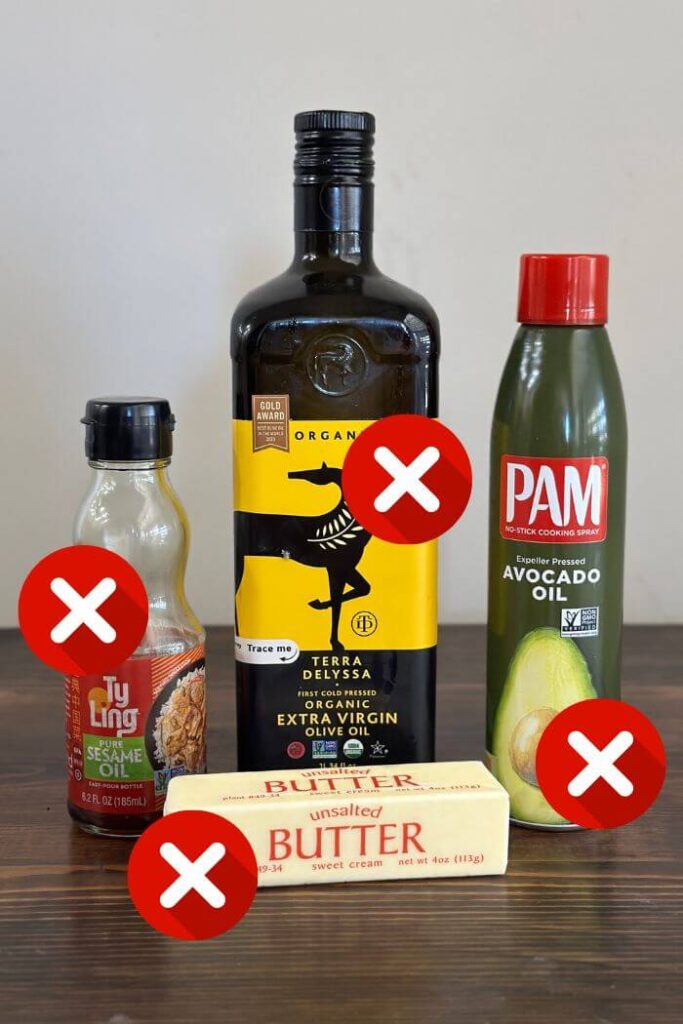
- Extra virgin olive oil – Using extra virgin olive oil for griddle seasoning is one of the biggest mistakes that I see people make. While this type of oil is great for dressings and some types of cooking, using EVOO at higher temperatures for griddle seasoning leads to the oil breaking down, and creating a sticky and less durable seasoning layer.
- Coconut oil – Unrefined coconut oil has a relatively low smoke point, and its coconut flavor may not be suitable for all dishes. When used for griddle seasoning, it can become sticky and may not create a durable non-stick surface, especially in comparison to oils with higher smoke points.
- Sesame oil – It’s important to distinguish between light and dark sesame oil varieties, but most that you find on grocery store shelves are dark sesame oil. Because of its rich and nutty flavor, dark sesame oil is best used as a finishing oil to flavor fried rice and other Asian dishes, and it’s not the best oil for seasoning a griddle.
- Non-stick aerosol sprays – Non-stick sprays like Pam may be great for getting your cake to come out of the pan easily, but when added to a griddle surface, the additives such as lecithin can actually harm your flat top grill surface over time. Best to steer clear of aerosol sprays for griddle seasoning.
- Butter – Butter has a low smoke point around 350°F, and it’s notorious for burning at high temperatures – that’s why I recommend adding a squirt of avocado oil to your butter on the griddle as it’s melting for certain recipes like griddle scrambled eggs. So you definitely don’t want to season your griddle with it.
- Flavored oils – Oils infused with herbs, spices, or other flavorings may contain additional substances that can leave residues on the griddle surface. These residues might interfere with the seasoning process and compromise the non-stick properties of the griddle.
- Bacon grease – Great in your green beans, NOT great as a flat top grill seasoning oil. This animal fat is more prone to molding on your griddle surface if you don’t use the griddle that frequently.
FAQ’s about Griddle Seasoning Oils
Can I use extra virgin avocado oil for griddle seasoning?
While extra virgin avocado oil is great for salads and dressings, it has a lower smoke point making it a poor choice for griddle seasoning oil.
In fact, I have had a few readers and YouTube subscribers reach out for help when seasoning their flat top grills, and they have told me that they used extra virgin olive oil and the result was a very sticky and poorly seasoned griddle top.
Can I use butter for griddle seasoning?
Butter has a low smoke point and contains milk solids that can burn at high temperatures. It’s not recommended for griddle seasoning. Stick to oils with higher smoke points for this purpose.
How do I season my Blackstone griddle?
Once you’ve selected the best oil for seasoning a griddle, you can find a step-by-step guide to how to season a griddle here.
What about the Blackstone Griddle Seasoning and Cast Iron Conditioner?
Blackstone makes their own griddle seasoning oil, except in a solid form similar to vegetable shortening. This griddle seasoning product contains “a proprietary blend of palm oil, shortening, beeswax, canola, and soy oil“.
I have used the Blackstone griddle seasoning and conditioner in the past with good results, and since Blackstone is THE largest griddle manufacturer with a ton of Research and Development backing their products, this conditioner is a safe bet. I personally prefer using avocado oil, however, because it is more of a multi-purpose product since I am able to cook with it as well.




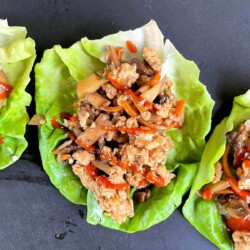


Comments & Reviews
Kevin says
What do you think of using south Chicago wagyu tallow for the seasoning process?